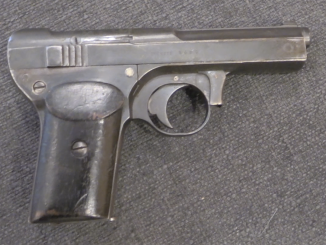This is lot #3540 in the upcoming RIA Premier Auction. It was scheduled for April, but has been postponed – check their web site for upcoming Online Only auctions every month, though!
The Le Français pistol was designed by Etienne Mimard in 1912, and listed in the Manufrance catalog in 1914. It was a .25ACP (6.35mm Browning) civilian defensive pistol for pocket carry, and designed with elements specifically for that purpose. It had a long double action trigger instead of a manual safety, and used a tip-up barrel to avoid requiring the slide to be manually cycled.
In 1928, Manufrance introduced a much larger version of the gun chambered for 9mm Browning Long (9x20SR), named the Type Armée. It was envisioned as a military service pistol, and was tested several times by the Versailles Commission. It was never found satisfactory, basically because the loading mechanism and trigger were much more suited to a pocket pistol than a service sidearm. The lack of an extractor was also not appreciated by the military trials commission.
Despite military rejection, about 4900 of the guns were sold, including some to officers who had to procure their own personal weapons. The first 1100 (1928 pattern) had a smooth barrel, and the remaining 3600 or so (1931 pattern) had a distinctive finned or ribbed barrel.




Very well designed and made pistol… Once getting used to its loading, it shoul be not confusing. Using strong recoil springs to slow the bolt backward travel may be seen clever in powerfull rounds recoil management but it should also be remembered that they reflect collected recoil impact to the returning stage as violently battering the barrel and engaging surfaces as causing tear and wear… lt seems dismounting process needs some more thinking as not leaving more little pieces subject to be lost. lMHO…
I agree with you on first part… this is really well thought out product. At the subject of returning spring though, I feel it is smart too. Look at ratio of arms (small spring – long slide) and as a result limited range of spring compression. So, the spring works with almost constant load. True French, any way you look at it.
Thanks Denny… lt seems to me, spring compression stroke and lever ratio being choosen accoding to the acceptable bolt travel and with extra force which being not be tried for manually retraction, with an indicator having no holding serrations and my statement was roughly for general application, not strickly for this sample…
My pleasure to discuss with you Strongarm!
I think we can be certain, they chose sufficient amount of force with some small surplus. To strip shot from full magazine takes some effort.
WOW talk about a weird gun to take apart. I frequently have a person bring an older gun to me to have me show them how to maintain it. I’m sure glad that no one has brought one of these to me! The color case hardening on the trigger is amazing. I assume that it is primarily for looks.
Very interesting weapon!
But please, Ian…. you repeatedly call the recoil spring the “mainspring” which it is not. The mainspring is the spring that drives the striker or the hammer and actually fires the weapon. Just because the recoil spring is bigger doesn’t make it the mainspring.
The name, in France, of this gun is ” Le fFancais Type Armee”, like it is written on it, not France or La France, the same as a 1892 revolver is a “1892” and not at all a Lebel.
Is the name attributable to French person of female gender? Just for curiosity sake.
More I think about think about name more fitting to RiseOfNationalism-era it seem.
Did some German firm made automatic pistol named Deutsch or similar or say Englishmen in Great Britain?
Actually, the Ortgies family of pocket pistols had a really cool sort of Art Deco/ German expressionist sphinx that formed a stylized “D” for Deutschland on the grips. Very elegant. The sort of pistol Ian Fleming’s master-spy 007 might have used had it been set in the 1920s instead of the Cold War.
There was, of course, the British Bulldog revolver. Generally a type but some were marked as such. Usually those originating in the U.S. or Belgium. No connection with Velodogs used by French bicyclists to ward off mans best friend.
“(…) Le Français pistol was designed by Etienne Mimard in 1912, and listed in the Manufrance catalog in 1914. It was a .25ACP (6.35mm Browning) civilian defensive pistol for pocket carry, and designed with elements specifically for that purpose.(…)”
It is worth noting that in this automatic pistol there is no way of forgotten cartridge in chamber after removing magazine. In these time there were case when users (accustomed to revolvers) assumed that after removing magazine automatic pistol is safe, which sometimes resulted in unexpected shots.
“(…)9mm Browning Long(…)”
According to https://unblinkingeye.com/Guns/Francais/francais.html
According to Huon, some documents specify a reduced load for the cartridge–and the 9mm Browning long was already considered marginal.
It’s still the most common cause of unintentional discharges. Every gunsmith can tell daily horror stories about supposedly safe firearms, waved around by the owner, with a live round in the chamber.
The first pistol I know of with a magazine safety is the Brixia 1913.
Action reminded me of Beretta tip ups.
I suspect if you want this you will be bidding against Ian, so bid accordingly…
Yes, you are right… Ian wants to have this one in his collection 🙂
“(…)Action reminded me of Beretta tip ups. (…)”
See also Pieper automatic pistol:
http://www.littlegun.be/arme%20belge/artisans%20identifies%20p/a%20pieper%20nicolas%20gb.htm
XOR
Steyr Modell 1908:
http://hungariae.com/Stey08.htm
both have tip-up barrel and predate Le Français automatic pistol
Magqzine catch seems also smarter and if noticed slide bridge at the front having a hard soldered place indicating a crack been occured thereat. lf this common, it would be a clue for unsufficient bolt mass…
Ian, wouldn’t it be easier to remove the barrel pivot pin if you released the barrel latch first, to remove the side load from the pin?
Interesting design.
Under other circumstances, he could well have claimed the title of a people’s pistol.
Although you could make it even easier…
I think that the military career of this pistol was ruined by the completely idiotic fixation of the mag.
Sooner or later, and probably constantly-periodically, a loss of it is inevitable.
Ian, so that the pins during disassembly do not have to be pulled out with pliers, try to stop the load on them before removing them. 😉
For example, for this gun, you first need to fold the barrel. By the way, such a sequence seems more logical for safety measures.
I bet if “you” who me? Yes, but not just you. Had designed that; you’d be like, hey that is quite good (smiley face)
Don’t be so upset.
Before they completely stopped making weapons, the British confidently competed with the French, with their SA80, also predisposed to the loss of the mag.
Now the palm branch of the “creator of the most curious design” is vacant.
There is something to strive for. 😉
No, you perhaps misunderstood me… My fault (was a bit random; was based on Monty Pythons life of Brian) a scene… “Jesus” on the pedestal.
Rather mine.
I have a flickering perception of humor. 😉
To my view a ‘seriously odd’ (though obviously workable) pistol. Given that it presumably in production at the outbreak of WWI, what happened then? e.g. was production stopped and the capacity diverted to other uses. Or (given the French Army’s ‘considerable’ need for pistols) pressed into service or put forward (possibly in a more worthwhile caliber) for military contracts.
Do not lose such a great ability to complete your writing assignments with high quality to get the highest grades. You can achieve the best result with the expert writing services. They can do what you need. But, you should also know that you can use a special discount to pay less money for writing services.